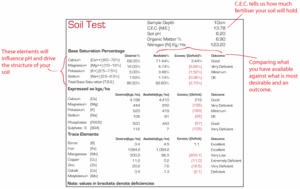Understanding our Soil Test

The Superior soil test compares each soil element against the ideal quantity and ratio for your crop and farm. The diagram on the right is a typical example of the information we gain from this test, which is used to develop your custom solid fertiliser:
Why do we only use our soil test?
Soil test results vary between laboratories due to different methods used and non standardisation of protocols between laboratories. For example, the standardisation of a soil test method involves defining parameters such as the solution mixed with the soil, how much solution is used, how long you shake a sample, what control or reference soil is used to calibrate instruments and compare your soil with, and so on.Our fertiliser recommendations use rules specific to our soil test and would have to be recalibrated if we were to use an alternative laboratory. Even after recalibration there is no guarantee the outcomes would be consistent.
Our tests are processed by an independent laboratory in Missouri, United States, ensuring a faster turnaround, better value for money.
Phosphate Levels: Olsen verses Bray?
Superior uses both the Olsen and Bray phosphate (P) tests as suitability depends on whether the soil is alkaline or acidic.The Bray-P2 test is a more reliable measure of plant available P on neutral (pH 7) or acid (pH < 7) soils, whereas the Olsen method is more reliable for in highly calcareous (lime containing) or alkaline soils (pH > 7.4).
It is therefore very important to use the correct test as using a Bray-P2 test on an alkaline soil tends to underestimate available P, whereas the same goes for using the Olsen on an acidic soil. Phosphorus (P) is an essential element for all plants, so it's important to know if the soil provides a sufficient concentration of P for optimum plant growth.
Since the majority of New Zealand soils are acidic, we commonly use the Bray-P2, but we still strike soils that have high pH's and therefore require an Olsen test. The Bray test has an advantage in that it measures any phosphate available from reactive phosphate rock (RPR) applications, which is important if you've been applying RPR. This is a major shortcoming of the Olsen test as it will not pick up reactive phosphate rock (RPR) residues.
Finally, it is important to remember that we use different scales for measuring phosphate levels when using Olsen and Bray tests. For example, a reading of 500kg/ha of available phosphate on an acid soil is excellent, whereas 125kg/ha is excellent on an alkaline soil.




